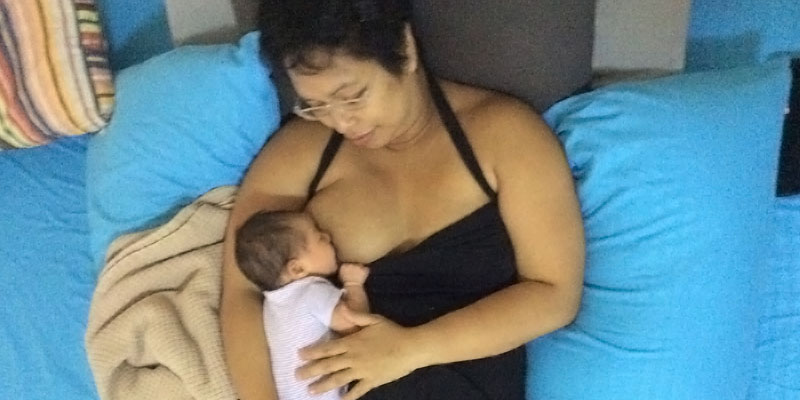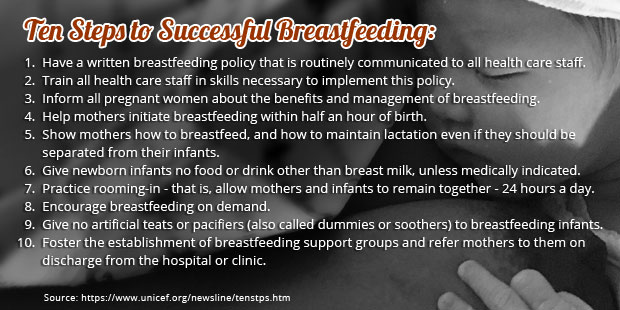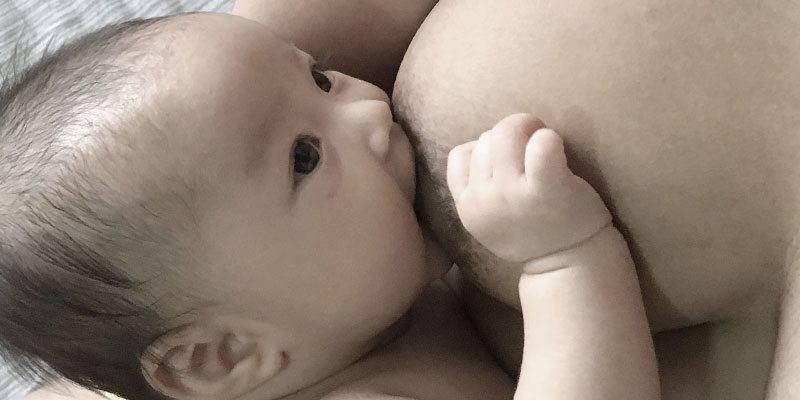I believe that every mother has her own unique and beautiful birth story–whether she had normal or CS delivery, a water birth or home birth, or if she gave birth in a ship or a plane. Along side this, each mother would also have her own unique and beautiful breastfeeding story–of how she started, of how she learned, of how she was able to continue for beyond 2 years, or perhaps, even of how she decided later on to stop.
Let me humbly share the story of the beginning of our breastfeeding journey. I say “beginning” because I know that truly this is just the start; my baby is 9 weeks old as of this writing, and I know—and hope and pray—that our journey will be long and sweet. ????
A brief background about our birth and delivery which I previously wrote about here: our baby girl was born mid-January of this year on a post-flood Tuesday evening via emergency CS due to arrest in cervical dilatation at 41 weeks and 2 days age of gestation.
I know theoretically that breastfeeding can be really challenging for the mother-baby dyad (or father-mother-baby triad, I should say) after a cesarean delivery. That’s why I was initially very resistant to the thought of undergoing CS.
So when my baby was brought to my chest for the first time while we were doing Unang Yakap at the operating room, I was really thankful, joyful, and excited to breastfeed my little one. Our pediatrician said that Tala cried right away upon delivery. She latched on to my breast in less than half an hour. That was such a happy thought for me! ????
Our first few hours post-op back in our hospital room come to me now as a haze. I vaguely remember my husband, Jerome, telling me not to worry about anything and to only focus on recuperating and breastfeeding our baby girl, who was of course, roomed-in with us right away. Oh, and he asked the nurse to show him how to change diapers! Hehe.
Initially, I breastfed Tala in laid-back position and eventually in side-lying position. The staff of Maria Reyna Hospital, specially the delivery room nurses, were very helpful in getting her to latch on to me properly. She was so tiny and light and calm; it seemed easy to breastfeed her at that time. Our pediatrician and the residents noted her to have good suck, she pooped and peed, and so I knew we were on the right track.
But what’s a journey without challenges, right?
![]()
My first challenge: post-operative pain.
Of course I had pain medications; even Tramadol IV, on standby as needed if I remember correctly. I thought I had high pain tolerance because I could breathe through the labor contractions, but I guess I was wrong. The pain on my surgical site was really bothersome. Perhaps I had low pain tolerance after all. It was so difficult and painful to move, even to just roll from left to right on the bed. I was trying to rationalize the pain: maybe it’s because I’ve never had a major operation before; and I am so used to always having freedom of movement, and I really moved a lot through yoga, swimming, zumba, etc. I told myself, “Now I am limited by the pain, that’s why it hurts a lot.”
But my OB reminded me that movement and ambulation will help me recover faster.
So I still tried my best to move in bed (no matter how slowly I did so), eventually sit up (even if I had to hold on tight to Jerome and repeatedly say “I don’t know how to sit up without using my core”—haha, yogi speak, I guess), go to the bathroom (hunched over because lifting my torso felt so painful), and even take a shower (because I just had to, yeah, despite the pain). I cried several times and I told Jerome over and over again specially whenever I had to go to the bathroom, “It’s so painful…It’s so hard to move…”
Eventually the pain became a bit tolerable and we went home a couple of days after my operation.
![]()
My second challenge: sore and cracked nipples.
Our first two days at home was incredibly hard and agonizing (maybe because also of the stressful aftermath of the flood—our house was still a disaster area when we arrived). My nipples were sore already in the hospital, then at home, I probably was not able to correct Tala’s latch during the night because I was still exhausted and was still in pain. I continued nursing even if it hurt because I was more concerned with the pain on the surgical site of my abdomen. I might have dozed off while she nursed with an incorrect latch. (I realize now that it was a big mistake. I should have invested more time and effort mastering how to properly latch Tala to avoid what happened.)
The tips of my nipples cracked and bled. Every time I would bring Tala to my breast I would hold my breath and when she starts suckling I would wince and tense up in toe-curling pain. Many times I would press my feet on Jerome’s body, almost kicking him. It was intense. Tenderness can be expected in the first few days for a newbie breastfeeding mom like me, but as my lactation consultant friend reminded me, it should never be a “toe-curling pain”. So I knew something was wrong.
Jerome would assist me by holding our baby while I positioned myself using as many props as I needed : pillows, rolled towels, foot rest. Then he would help Tala latch on to me. He massaged my shoulders and back as I sobbed and endured the pain, just so we could feed our baby.
Oh I cried! A lot. Before, during, and after breastfeeding. Those who have been in this situation would know what I mean.
Because of those first two days back home, I now understand why some mothers would reach THAT point of giving up on breastfeeding. The initial experience will test you; it tested me. I was already anxious, discouraged, and utterly exhausted. Add to that the fear that I might harm my baby in some way, or I might starve her. I was getting paranoid too, to tell the truth.
Through my tears I would speak loudly so that Tala and Jerome can hear, and so that I can hear myself too :
“I will not give up. I promise, I won’t give up.”
“Lord, please help me…”
“I can do this… I can do this… I can do this!”
Jerome would pray with me and affirm me, “Yes Langga, you can do this.”
On our third day at home, Tala was around 4 days old then, I came to my senses and did something proactive despite my exhaustion. I decided to ask for help.
Jerome has heard me say this many times when I encounter mothers having breastfeeding challenges: for every breastfeeding problem, there is a solution. And so when I told him that I need help already, he was more than 100% supportive.
We’ll be having our first check-up with our pediatrician that upcoming Monday, but since it was still Saturday, I thought of asking help from my breastfeeding peer counselor friends from Modern Nanays of Mindanao (MNM). I sent them a message early that morning and right away that same day, after lunch, Nadine Betonio, came to my house.
Nadine patiently listened to me as I narrated—more like ranted—what happened. I cried. For the nth time.
I won’t go into the details of how Nadine was able to fix Tala’s latch, that will be a story for another time, but one thing I really want to share was how she comforted my desperation. Her disposition was compassionate, her words were kind and understanding, her hands were gentle and eager to help. She let me show her what I have been doing and without judgement, gave me pointers and suggestions on how I can breastfeed Tala more comfortably.
She stayed with me until I could make Tala latch on to me without any pain, or at least minimal tenderness only. Cross-cradle for the left breast, football hold on the right breast. Check.
And it happened! We did it. I was so relieved!
We chatted a bit more while I nursed Tala. I was so happy that I could breastfeed and talk at the same time already—such a big difference from what I have been enduring the past couple of days!

![]()
My third challenge: pressure.
Nadine gently pointed out that I pressured myself too much about breastfeeding.
Given that I am a pediatrician and a breastfeeding counselor, given that I give lectures and seminars about breastfeeding, given that I teach mothers/parents on how to breastfeed their babies and how to troubleshoot their problems, perhaps I thought that I could do it just right. In fact, I expected myself to do everything just right the first time.
I was too cerebral about it, I forgot to be kind to myself.
Nadine kindly told me that challenges are understandable since Tala is my first baby and it was my first time to breastfeed. And this is the reason why there are breastfeeding counselors who offer help in this situation. She told me not to let it stress me out anymore.
Nadine promised to be back in a few days and said that I was welcome to text her if I have any questions. About breastfeeding. About mommy-ing. That made me very hopeful.???? After she left, I felt refreshed and truly more confident about breastfeeding my baby.
Come our appointment with our pediatrician, my nipples were healing already, though I was still having some difficulty positioning myself and Tala. Our pediatrician taught me how to properly hold our baby in different positions, specially in cross-cradle which was my favorite when Tala was still tiny. She answered all my questions and concerns. She checked our latch and how we were doing with our breastfeeding. Best of all, she reassured us that our baby was doing fine, her weight was good, her jaundice was subsiding. All was well.
I just had to hear it from her. All was well. ????
A few days later, as she promised, Nadine Betonio visited me again. This time with Nadine Casiño who is MNM’s spirited and dynamic founder. My concern at that time was not being able to rest, specially at night since my baby would nurse every 1-2 hours then. They worked together to help me get into a better position that would allow me to nurse and yet rest. We talked about being a mother, having a Montessori inspired home set-up for our kids, breastfeeding counseling, and many other things. I was thinking to myself that the 10th step to Successful Breastfeeding REALLY works; mother to mother community support is so important!

I was so grateful to have them both that day; angels disguised as breastfeeding counselors. ???? I promised them, and myself, that I shall pay this kindness forward. ????
And so looking back, I believe my breastfeeding journey started already a few years back—not the first time my baby was placed on my chest, but rather that moment when I said to myself, “Someday, I will breastfeed”. As early as then, I was already preparing.
So to speak, my journey started a few years ago when I began reading about breastfeeding and realizing once more how amazing God’s design is about our human body and physiology. There is so much to know! It continued when I trained under Arugaan and Breastfeeding Pinays to be a counselor, then I underwent the lactation management training by DOH, and worked with a few LATCH counselors in our mother’s classes back in Manila.
Around two years ago, I met five other pediatricians in a breastfeeding convention who have lactation support at the heart of their practice. Since then, we’ve had this Viber group chat where we daily share our experiences and clinical challenges, and in so doing, we are learning together and learning from one another even if we are from different parts of the country.
When we moved here to CDO from Manila just last year, I was happy to find out that I am surrounded by several breastfeeding advocates here! At the forefront is our own pediatrician, Dr. Jessa Sareno. Then we have the Modern Nanays of Mindanao—a recipient of the TAYO award just last month. Even in my own circle of friends from highschool, there are a number of breastfeeding mothers too!
And so, when my turn to be a mother came, my breastfeeding journey simply continued. Fortunately also, since I have personally witnessed post-CS mothers successfully breastfeeding their babies, exclusively even, I believed that I can do it too despite our unexpected operation. Close to home, I have my own OB, Dr. Ghea Mata-Carillo, and my pediatric cardiologist friend, Dr. Josephine Dela Cerna—who both gave birth via CS four months before me to my adorable “inaanaks”—inspiring and encouraging me to exclusively breastfeed like them.
Now I can truly say that despite the challenges Jerome and I encountered (and we know that there will be more hurdles to overcome), we are now happily breastfeeding our little girl.
![]()
With expectant mothers in mind, we would like to share how families can prepare for breastfeeding:
1. Prenatal Education. We have to try to learn about breastfeeding prior to giving birth because at this time we are more receptive to learning when our babies are still inside our wombs (but it’s never too late to learn if we have given birth already).In general, there are two parts to this. One, we will learn the theoretical part about its health benefits for the mother and child, the dangers of formula feeding, and the life-long impact of breastfeeding. Two, we will understand that breastfeeding is a skill, in the sense that it can be learned and indeed it gets better with practice. Position and latch, breast care, massage and hand expression are useful skills for the success of breastfeeding.
So, we have to be proactive in looking for and attending seminars and workshops. Why? Because although breastfeeding is natural, we have to face the reality that somehow our breastfeeding culture has taken the backseat—at least that’s how it is in my immediate community growing up. If we have no one to teach us or encourage us along the way, we might give up on it easily.
Thankfully, through the efforts of breastfeeding advocates and professionals, education is now readily available. Search for mothers’/parents’ classes or prenatal classes in your area. Usually hospitals would have such. Maria Reyna Hospital would have it every first Saturday of the month. Mother communities would also have such classes or at times informal meet-ups where breastfeeding experiences are discussed and shared. Check out the Facebook page of MNM for updates.
2. Family Commitment. Breastfeeding involves the whole family. It begins with the husband and wife as they prepare for newborn care, which includes deciding on what to feed their new baby. Sometimes we take it for granted and don’t think about it anymore—of course we will give our baby milk! But it is also important to evaluate and decide on what kind of milk that would be. Breastmilk is best for babies—oh yes, but it would be noteworthy to know and take to heart why! In many cases, our extended family is also in the picture. So it is important that the grandparents, aunts and uncles, and in-laws who are going to be involved in the care of our child, would also understand the parents’ decision to breastfeed so that they can be a source of encouragement.
3. Healthcare Provider and Patient Partnership. The first breastfeed ideally would occur within the first hour of the baby’s life provided that all is well with both the mother and the newborn. This will have an impact on the entire breastfeeding experience of the parents and their baby. So it is important that our doctors (both OB and pediatrician), or midwives as the case may be, are on the same page as us. They are our partners in providing sound medical advice with regards to breastfeeding our babies.
![]()
To end this long post (pardon me for I always have a lot to say about this topic, haha!), I want to thank my husband Jerome for being my number one coach and supporter; our doctors Ghea and Jessa who gave us a good start with breastfeeding by providing us a beautiful Unang Yakap experience; Arugaan and Breastfeeding Pinays specially Nay Ines, Nay Rich, Velvet and Bing, and my batchmates; LATCH specially Marv, Jen, Paula and Charmaine; and Modern Nanays of Mindanao (mother to mother community rocks! An extra special shout out of gratitude to the two Nadines who came to my rescue—thank you for being my breastfeeding angels; and Ivy, I loved the lactation choco drink from Mother Nurture and thank you for introducing M2 malunggay tea to me, it’s a staple drink for me now!); my breastfriends—Kat (you’re one of the reasons why I am into this, hehe), Marini, Iris, Charms, Ann, and Claire; Dr. Cristina Bernardo for always encouraging us to learn more and pursue this path; my breastfeeding inspirations—Monica (the breastfeeding essentials you gave really helped a lot!), Gwenn (thanks for the super comfy nursing wear, hehe), and all the working mothers and stay-at-home moms (too many to mention, but you all are amazing!) who show me through their everyday lives how it’s done.

Philippians 4:13 (ESV)
I can do all things through Him who strengthens me.
